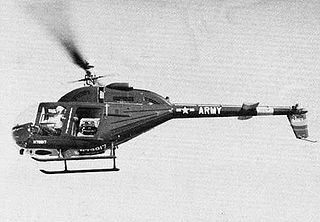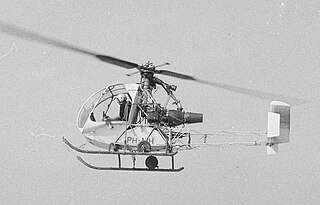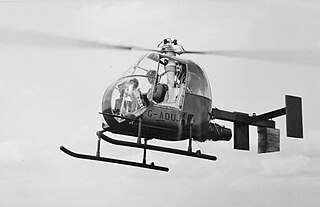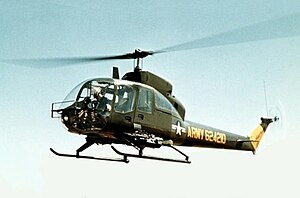
The Bell OH-58 Kiowa is a family of single-engine single-rotor military helicopters used for observation, utility, and direct fire support. It was produced by the American manufacturer Bell Helicopter and is closely related to the Model 206A JetRanger civilian helicopter.

The MBB/Kawasaki BK 117 is a twin-engined light utility–transport helicopter. It was jointly developed and manufactured by Messerschmitt-Bölkow-Blohm (MBB) of Germany and Kawasaki of Japan. MBB was later purchased by Daimler-Benz and eventually became a part of Eurocopter, which was later rebranded as Airbus Helicopters.

The AgustaWestland AW109, originally the Agusta A109, is a lightweight, twin-engine, eight-seat multi-purpose helicopter designed and initially produced by the Italian rotorcraft manufacturer Agusta. It was the first all-Italian helicopter to be mass-produced. Its production has been continued by Agusta's successor companies, presently Leonardo.

The Hughes OH-6 Cayuse is a single-engine light helicopter designed and produced by the American aerospace company Hughes Helicopters. Its formal name is derived from the Cayuse people, while its "Loach" nickname is derived from Light Observation Helicopter (LOH) program under which it was procured, and likely the word "chopper", a common nickname for helicopters.

The Aérospatiale Alouette II is a French light helicopter originally manufactured by Sud Aviation and later Aérospatiale. It was the first production helicopter powered by a gas turbine engine instead of the heavier conventional piston powerplant.

The Bell 206 is a family of two-bladed, single- and twin-engined helicopters, manufactured by Bell Helicopter at its Mirabel, Quebec, plant. Originally developed as the Bell YOH-4 for the United States Army's Light Observation Helicopter program, it was not selected by the Army. Bell redesigned the airframe and successfully marketed the aircraft commercially as the five-place Bell 206A JetRanger. The new design was eventually selected by the Army as the OH-58 Kiowa.

The Bell 407 is a four-blade, single-engine, civil utility helicopter. A derivative of the Bell 206L-4 LongRanger, the 407 uses the four-blade, soft-in-plane design rotor with composite hub developed for the United States Army's OH-58D Kiowa Warrior instead of the two-blade, semi-rigid, teetering rotor of the 206L-4.

The Messerschmitt-Bölkow-Blohm Bo 105 is a light, twin-engine, multi-purpose helicopter developed by Bölkow of Ottobrunn, West Germany. It was the first light twin-engine helicopter in the world, and the first rotorcraft that could perform aerobatic maneuvers such as inverted loops. The Bo 105 features a hingeless rotor system, a pioneering innovation in helicopters when it was introduced into service in 1970. Production of the Bo 105 began at the then-recently merged Messerschmitt-Bölkow-Blohm.

The Hiller OH-23 Raven is two or three-place, military light observation helicopter based on the Hiller Model 360. The Model 360 was designated by the company as the UH-12, which was first flown in 1948. Initially it was two-place helicopter powered by a piston engine that entered service in the late 1940s, it went on to be a popular military and civilian light helicopter in the late 20th century. A Hiller UH-12 was the first helicopter to make a transcontinental flight across the USA, in 1949. It served in the Korean War with U.N. forces and also in Vietnam. It was an important early helicopter and was widely used internationally, and in U.K service it was called the Hiller HT Mk 1 and Mk 2; and the U.S. Navy also used it as the HTE-1 for training. It was sold commercially as the UH-12, though some military operators used the company designation. Some later models were designed for turbine power, and version with 4-seats was also sold. In Canada, UH-13E served the military as the CH-112 Nomad.

The Schweizer S300 series family of light utility helicopters was originally produced by Hughes Helicopters, as a development of the Hughes 269. Later manufactured by Schweizer Aircraft, and currently produced by Schweizer RSG, the basic design has been in production for over 50 years. The single, three-bladed main rotor and piston-powered S300 is mostly used as a cost-effective platform for training and agriculture.

The Hughes TH-55 Osage is a piston-powered light training helicopter produced for the United States Army. It was also produced as the Model 269 family of light utility helicopters, some of which were marketed as the Model 300. The Model 300C was produced and further developed by Schweizer after 1983.

The Allison Model 250, now known as the Rolls-Royce M250, is a highly successful turboshaft engine family, originally developed by the Allison Engine Company in the early 1960s. The Model 250 has been produced by Rolls-Royce since it acquired Allison in 1995.

The MD Helicopters MD 500 series is an American family of light utility civilian and military helicopters. The MD 500 was developed from the Hughes 500, a civilian version of the US Army's OH-6A Cayuse/Loach. The series currently includes the MD 500E, MD 520N, and MD 530F.

The MD Helicopters MD Explorer is a light twin-engined utility helicopter designed and initially produced by the American rotorcraft specialist McDonnell Douglas Helicopter Systems.

The Bell YOH-4 was a single-engine, single-rotor light helicopter, developed for the United States Army's Light Observation Helicopter program. While the YOH-4A was unsuccessful in the original LOH competition, Bell redesigned it as the sleek Bell 206A JetRanger for the commercial market, and enjoyed instant and lasting success. In 1967, the Army reopened the LOH competition, and the 206A-based OH-58 Kiowa was selected.

The EurocopterAS355 Écureuil 2 is a twin-engine light utility helicopter developed and originally manufactured by Aérospatiale in France.

The Light Observation Helicopter (LOH) program was a United States Army program to evaluate, develop and field a light scout helicopter to replace the Army's aging Bell OH-13 Sioux. It gained impetus with the advent of the Vietnam War, and was aided by advances in helicopter technology, specifically the development of the turboshaft engine.

The Sud-Ouest SO.1221 Djinn is a French two-seat light helicopter designed and manufactured by aircraft manufacturer Sud-Ouest (SNCASO), which was later merged into Sud Aviation. It was the first production French helicopter, as well as being one of the first practical European helicopters to be produced. The Djinn was also the first rotorcraft to harness tip-jet propulsion to enter production.

The Fairey Ultra-light Helicopter was a small British military helicopter intended to be used for reconnaissance and casualty evacuation, designed by the Fairey Aviation Company.

The Filper ResearchModels Beta 200 and Beta 400 were small tandem, rigid rotor, helicopters intended for the personal helicopter market. Filper Research, located in San Ramon, California, was in existence from 1965 to 1968. The Beta 200 was a two place helicopter and the Beta 400 was a four place helicopter. One Beta 200 prototype and one Beta 400 prototype were manufactured and flown. Several pre-production airframes, which never flew, were also manufactured. Development testing was done in the experimental category. Development was not completed and Filper did not apply for an FAA Type Certificate for either type. There were several other variations on the basic Beta design which were contemplated but these were never developed beyond the conceptual stage. There was a fatal crash of the Beta 400 prototype in November 1967 and the company ceased operations in April 1968.






















